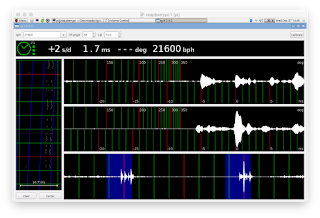There are a handful of watch regulation apps out there but this caught my eye because of the time variance graph display in the same vein as a hardware timegrapher. Look-So what does it do? Essentially you use an external microphone mechanically coupled to the watch. The app 'listens' to the watch heartbeat and provides diagnostic information. Tanglou Wrist Watch Tester Timing Multifunction Timegrapher NO.1000 Watch Testing Calibration Tool Calibrator Machine. 4.7 out of 5 stars. FREE Shipping by Amazon. In stock on April 24, 2021. Most well adjusted watches (using regulating pins or not) will only have a small increase in variation due to isochronism in the first 24 hours. It's after that when the timing starts to drift more with a watch of a 'typical' reserve is involved (approx. And yes the method of regulation is the timing screws on the balance. Tg is a timegrapher program: a software used to regulate mechanical watch movements and evaluate their performance. Tg detects the noise produced by the mechanism of a watch, analyzing that noise it computes real-time readings of the rate (i.e. How fast or slow the watch runs) and other operational parameters (beat error, amplitude). Shoot me a PM would love to make your noisy watch silent! Rotor silencing, timegrapher regulating, demagnetizing, & 50meter water test services available!
When this watch was made, thin was in. Pocket watches were toward the end of a long swing in consumers’ size preferences.
In the beginning there were huge 18-size full-plate pocket watches in beefy silver cases, and all was good. But then tastes changed to the smaller 16-size, and 18s never recovered their popularity.

Eventually, consumers turned to 12-size pocket watches, which were sleek and svelte compared to the 18s and 16s watches. With the change in diameter came a change in thickness. Many companies—Gruen being foremost—used thinness as a selling point, and consumers responded.
Our current watch—a 12-size Hamilton 912—reflects this trend. Intended for everyday users, rather than railroad workers, this watch is slim and compact. The 12-size Hamiltons are unusual because they were factory cased. They don’t quite fit standard 12s cases, being either a bit too big or too small. That’s why you see so many uncased 12s movements for sale.
I bought this watch as part of a clearance batch at a local consignment shop. The watches were good—the 21-jewel Burlington we recently adjusted, an Elgin 339, and a 16s Waltham were among them—but they each had a flaw that would discourage a casual buyer, such as missing hands or crystals. This watch was missing its crown and crystal, but I snatched it happily. The original factory case alone was worth much more than I paid for it.
A Hamilton 912 was originally adjusted to 3 positions. For pocket watches, the 3 positions are dial up and down (DU, DD) and pendant up (PU). Let’s see what we can do with this little fellow.
Watch Timegrapher Machine


As usual, the watch got a good scrubbing, a new mainspring, and a trip to Dr. Demagnetizer. Unfortunately, it needed some repairs. One of the balance staff pivots was bent and deformed, causing huge timing differences between the dial up and dial down positions.
As we described in our post on bent pivots, it’s best to replace the staff than to fiddle around with pivot straighteners, and that’s what we did here.
For this watch, the omens for close time are mostly good:
- Hamilton made great pocket watches. A 17-jewel, adjusted movement from the 1920s has great potential.
- The movement is clean, and the timing traces are clean, parallel, and stable.
But there are some bad signs, too:
- The balance wheel had some of the saddest, most mangled screws I have ever seen on a quality watch. One screw was a hacked-off lump. There was no screw slot, just a misshaped and chiseled screw head.
- Another pair of screws had been madly undercut—about half of the screw body was missing. And then timing washers were put under them.
- Finally, the watch ran surprisingly well with a deformed balance pivot because someone replaced the balance jewels with improperly sized ones. These jewels were thick enough to reduce the endshake for the crushed pivot. The bad staff would thus tick, but a proper staff wouldn’t fit.
Clearly, this watch has handled by someone with bad skills and low standards at some point.
Before adjusting, I replaced the balance staff and the balance jewels. For the wheel, I hit the reset button by removing all the hacked-off screws and replacing them with pristine screws from a parts watch. If you do this, you must replace screws in opposing pairs so that they are similar in weight. Otherwise, you’ll have a poise disaster.
Eventually, the watch was ready for being adjusted to positions. How did it look?
Not too bad, actually, especially given the new staff and screws. The DU and DD positions are basically alike, and this always bodes well. The beat error, however, was huge—around 6 ms.
Normally, I march through the steps of adjusting:
- we start by setting the watch in beat, if necessary, and then reading the rates at low amplitude to isolate the heavy spot
- we make an adjustment, usually adding weight to the light spot or removing weight from the heavy spot
- we fully wind the watch and see how the rates change
- we start again, repeating the cycle until the watch meets our goal for accuracy
For this watch, we’ll elide over the many steps because there were simply so many. (Readers looking to learn adjusting should read the Dynamic Poising series in order and have a look at a fewexamplewatches.)
Adjusting this #$@% thing took forever.
- Getting this watch in beat is something of which we shall never speak again.
- Thin watches can be vexing to work on, and setting up and maintaining the proper clearances between the escapement elements was tricky. I hereby vow never to remove the balance with its accursed fiddly hairspring stud again.
- Twice, I took apart the watch to clean the gear train because of a fur attack from my cat. The cat is banned from the watch room, but do cats listen? Do they?
- It seemed like every heavy spot was between screws rather than at one.
But patience is rewarded. Some time later, we arrived here:
And that’s about as good as it gets for an old pocket watch. The 3 main positions are identical, the 5 primary positions are essentially at zero, and the most deviant position is the 6th one, where we can expect a bigger timing error.

My irrational side wonders if this watch could hit the Big Doughnut: perfect zero rates in all positions. But the rest of me—especially the part that remembers how many rounds it took to get to this point—has decided not to tempt fate. I’m going to put down my balance screw holders and screw slot files and let this one be.
Here it is with its new crystal, looking sharp.
This was a trying watch in many ways, but it was basically a solid timepiece once the havoc wrought by an early watchmaker was undone. With a new staff, jewels, and screws—and perhaps 15 rounds of dynamic poising and 2 rounds of cleaning—I got good results. Patience is not always rewarded so handsomely, but it does favor the diligent watch adjuster.
For the curious and the skeptical, here are the Timegrapher readings for all 6 positions. The watch ran for at least 30 seconds in each position, and the rate is based on a 12-second running-average window.
DIAL DOWN
How To Read A Timegrapher
PENDANT LEFT
Timegrapher Windows For Regulating A Watch Repair
PENDANT DOWN